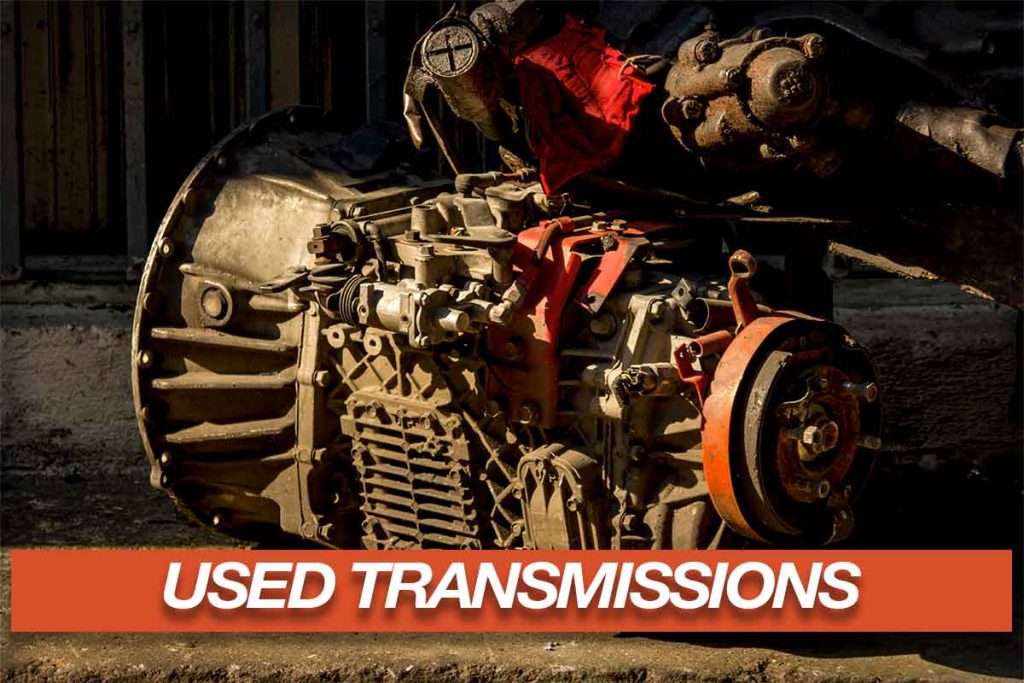In the world of auto repairs and vehicle maintenance, the choice to buy a used transmission from a junkyard or salvage yard can be both economical and environmentally friendly. This article delves into the reasons why people opt for used transmissions, highlighting the significant cost savings compared to purchasing new or rebuilt ones. Additionally, it emphasizes the importance of selecting the right junkyard, one that offers a reliable warranty on used transmissions, ensuring customer protection.
Why Choose a Used Transmission from a Salvage Yard
Salvage yards, often a treasure trove of quality used auto parts, offer a viable option for those seeking affordable transmission solutions. Opting for a used transmission from a junkyard isn’t just about cost-effectiveness; it’s also a form of auto recycling that contributes to environmental conservation. When you opt to buy used transmissions, it’s crucial to assess the quality and reliability, as these elements greatly influence the lifespan of the part.
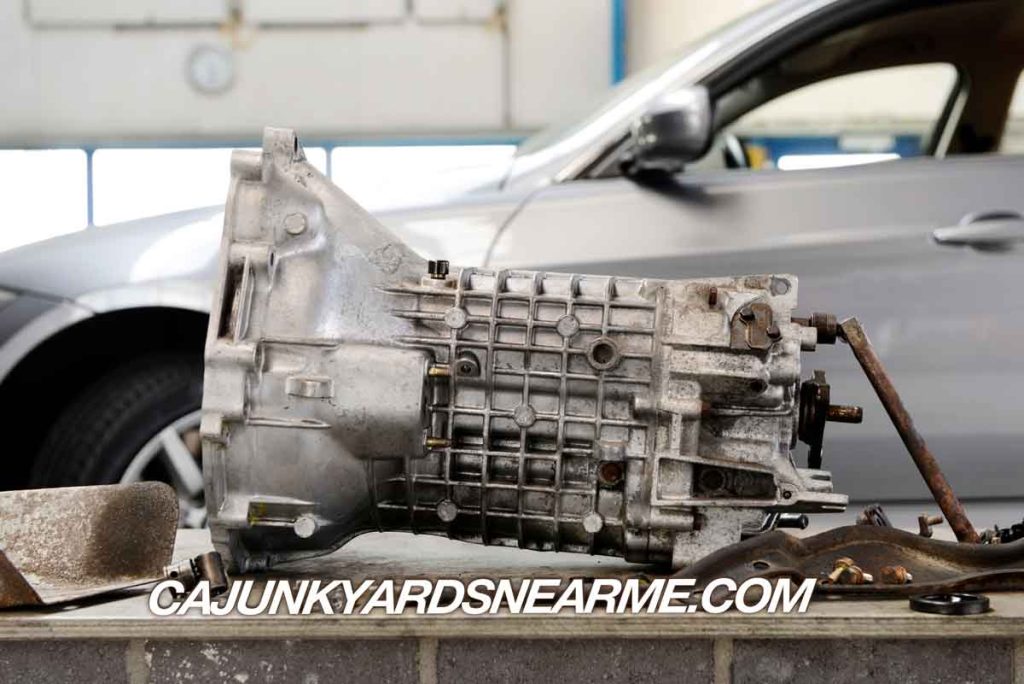
Understanding the Value of Used Transmissions
When considering the replacement of a vehicle’s transmission, understanding the value of a used transmission is paramount. This section aims to shed light on why used transmissions from junkyards are not just a cost-effective option but also a practical choice for many car owners.
The Sustainability Factor
One of the lesser-discussed benefits of opting for a used transmission is sustainability. By choosing a used part, you contribute to reducing waste and promoting recycling in the automotive industry. Salvage yards play a crucial role in this eco-friendly cycle, ensuring that functional parts from old or damaged vehicles are not discarded unnecessarily.
Cost Savings
The primary allure of used transmissions lies in their affordability. A new transmission can be prohibitively expensive, and even rebuilt ones can strain your wallet. Salvage yards offer transmissions at a fraction of the cost of new or rebuilt alternatives. This price difference doesn’t always reflect a compromise in quality; often, these transmissions are just as reliable as their newer counterparts.
How to Save Money with Used Transmissions
The decision to purchase a used transmission can lead to significant savings. This section explores how choosing a used transmission over a new or rebuilt one can be a wise financial decision, without compromising on quality and performance.
Understanding the Cost Differences
The cost difference between new, rebuilt, and used transmissions is substantial. A new transmission is the most expensive option, often costing several thousand dollars. Rebuilt transmissions, while cheaper than new, still involve considerable expense due to the labor and parts involved in rebuilding. In contrast, used transmissions from junkyards are significantly more affordable, offering the same functionality at a fraction of the cost.
Long-Term Savings
While the initial cost savings are evident, used transmissions also contribute to long-term savings. They can extend the life of your vehicle without the need for expensive overhauls or replacements. Additionally, the compatibility of a used transmission with your existing vehicle can lead to more efficient performance and reduced wear and tear.
Comparing Costs: New, Rebuilt, and Used Transmissions
To illustrate the cost differences, consider a comparison table showcasing the price range for new, rebuilt, and used transmissions. This table would include factors like the price of the transmission, delivery costs, and the length of the warranty offered. Such a comparison not only highlights the monetary advantage of used transmissions but also provides a clear perspective for making an informed decision.
The Role of Warranties in Cost Savings
Warranties on used transmissions can further enhance their value. A good warranty can offset potential repair costs that might arise after installation, ensuring that your savings are not negated by future expenses.
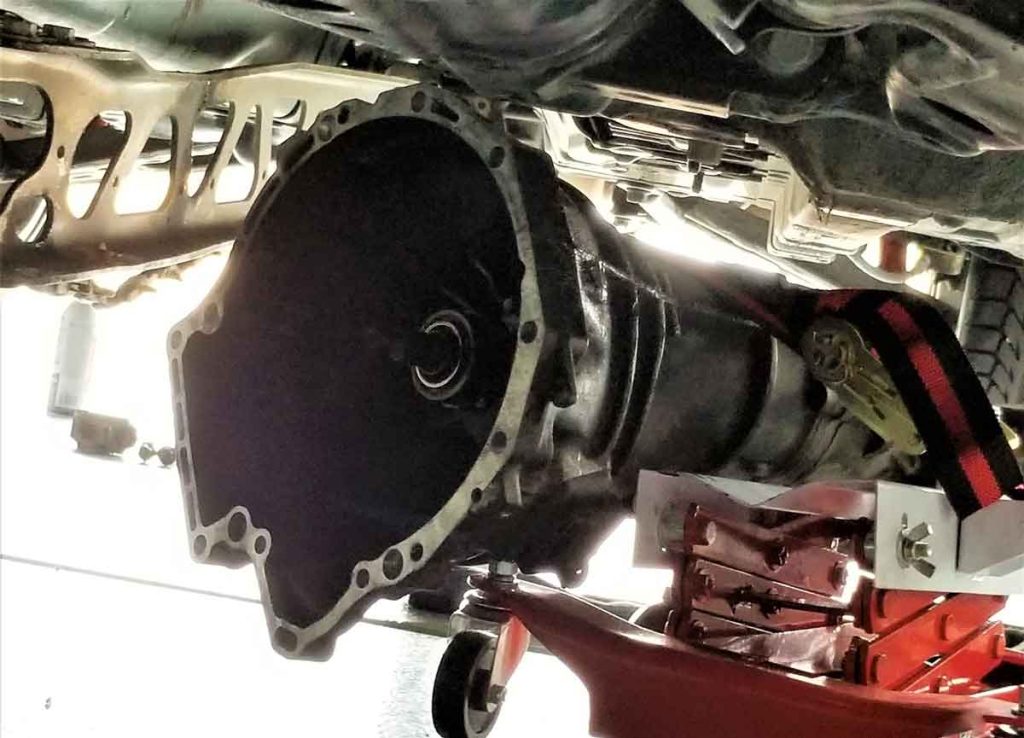
DIY Installation and Labor Costs
For those who are mechanically inclined, installing a used transmission themselves can lead to additional savings on labor costs. However, it’s important to weigh the benefits against the risk of potential mistakes and the value of professional installation.
Variety and Availability
Junkyards typically have an extensive inventory of vehicles, encompassing a wide range of makes and models. This variety ensures a higher likelihood of finding a transmission that matches your vehicle’s specifications. Whether you own a common model or a less prevalent one, chances are a local junkyard might have the part you need.
The Role of Warranties
A common concern when purchasing used auto parts is reliability. Reputable junkyards often address this concern by offering warranties on their parts, including transmissions. These warranties can vary in length and coverage, but they provide an added layer of security and trust in the transaction.
Expert Advice and Support
Many junkyard staff are knowledgeable about vehicles and can provide valuable advice on selecting the right transmission for your car. Their expertise can be particularly beneficial for those who may not be very familiar with auto parts and their compatibility.
In summary, understanding the value of used transmissions involves recognizing their economic, environmental, and practical benefits. As we explore further into choosing the right junkyard and the intricacies of selecting a used transmission, these benefits become even more apparent.
Ensuring Quality and Longevity in Salvage Yard Transmissions
When sourcing a transmission from a salvage yard, the key lies in thorough inspection. Look for vehicles marked as operational before reaching the salvage yard. Close examination is necessary to avoid transmissions with visible damage or wear. Salvage yards with a reputation for quality used transmissions usually mark vehicles whose engines were running at the time of their arrival, indicating a higher chance of operational integrity.
Steps to Inspect a Used Transmission at a Salvage Yard
Inspecting a used transmission before purchase is crucial to ensure its quality and suitability for your vehicle. This section provides a step-by-step guide on how to thoroughly inspect a transmission at a salvage yard.
Identifying Potential Donor Vehicles
Start by identifying vehicles that are likely to have a compatible transmission. Look for cars that match your vehicle’s make, model, and year. Remember, transmissions are not universally interchangeable, so precision in matching these details is key.
Visual Inspection for External Damage
First, conduct a visual inspection of the transmission. Look for any signs of external damage, such as cracks, rust, or visible wear and tear. Pay close attention to the transmission casing; any damage here could indicate internal issues.
Checking for Fluid Leaks and Quality
Inspect the transmission for any signs of fluid leaks. Check the ground underneath and around the transmission for any fresh leaks. Also, examine the quality of the transmission fluid; it should be a clear, reddish color and not have a burnt smell.
Evaluating Collision Damage
Vehicles that have been in a collision can still have a functional transmission, but careful inspection is necessary. Look for any signs of impact that might have affected the transmission. Focus on vehicles that have suffered side or rear collisions, as their transmissions are more likely to be unharmed.
Assessing Mounting Points and Connections
Inspect the mounting points where the transmission connects to the engine and the vehicle’s body. Ensure that these are intact and show no signs of excessive wear or damage. Also, check for any broken parts or unusual alignments.
Oil Pan and Engine Block Inspection
Examine the oil pan and engine block for any signs of damage. Look for holes, cracks, or any pieces that might be sticking out. Any such damage could be a red flag indicating internal problems with the transmission.
Seeking Professional Advice
If you’re unsure or lack experience in inspecting transmissions, seeking professional advice is always a good idea. A mechanic or an expert from the junkyard can provide valuable insights and help you make an informed decision.
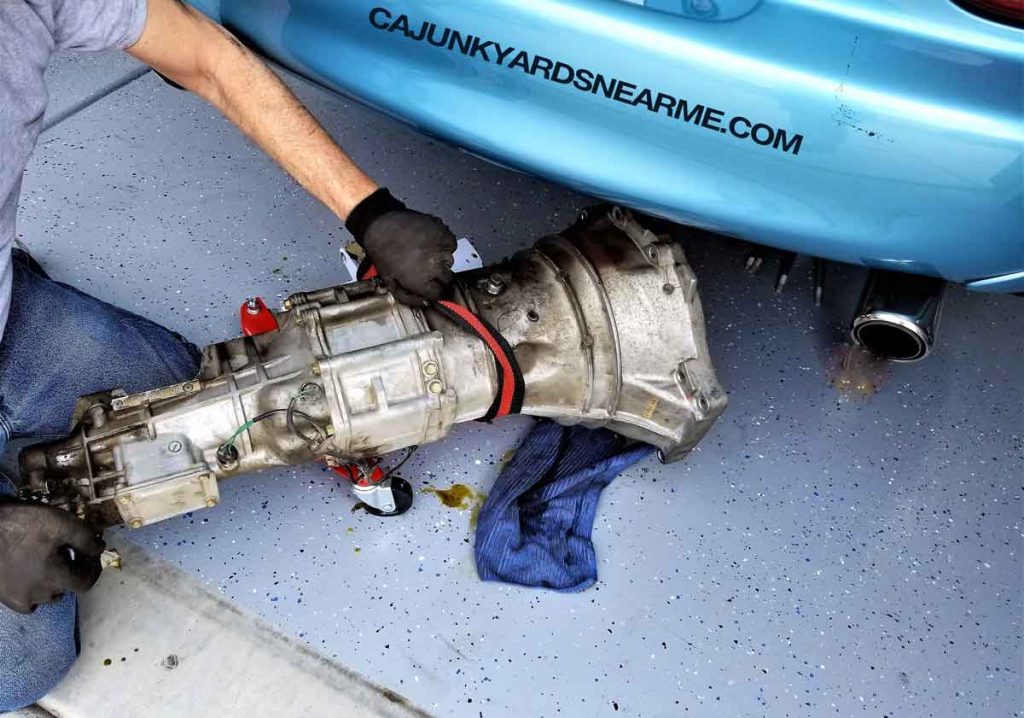
Financial Benefits: New vs. Rebuilt vs. Used Transmissions
The cost difference between new, rebuilt, and used transmissions is significant. New transmissions are the most expensive, while rebuilt ones offer a middle ground. However, used transmissions from junkyards present the most economical option without compromising quality. A detailed comparison, shown in a table format, will point out the differences in used parts condition, price, installation cost, and guarantee length.
Comparing Costs: A Detailed Price Analysis
In this section, an online search for transmissions will be conducted to compare prices of new, rebuilt, and used options. The data outlining the cost benefits associated with each type will be systematically arranged to highlight the value provided by buying used transmissions from junkyards.
Selecting the Right Junkyard for Used Transmissions
Choosing a reputable junkyard is crucial when purchasing a used transmission. A reputable yard should provide a guarantee that safeguards the buyer and ensures the functionality of the used transmissions being bought. The yard’s reputation, customer reviews, and the length of the warranty offered are important factors to consider.
Criteria for Choosing a Junkyard with Reliable Warranties
When assessing a junkyard, pay attention to the warranty terms. A longer warranty period often indicates confidence in the quality of the parts sold. It’s also advisable to inquire about the yard’s return policy and customer service standards, as these aspects are indicative of the yard’s reliability and commitment to customer satisfaction.
| Transmission Type | Part Condition | Price Range | Delivery Cost | Warranty |
|---|---|---|---|---|
| New | Brand new, manufactured to original specifications | $4,000 – $8,000 (varies by vehicle make and model) | Varies based on supplier and location | The guarantee period is often the longest, sometimes matching the manufacturer’s standard for new parts. |
| Rebuilt | Worn or defective parts replaced, quality of components varies | $2,800 – $3,800 (can vary based on parts and labor) | The cost relies on the provider and location; a local rebuilding can save costs and offer a wider inventory to choose from. | Typically 12 months/12,000 miles; terms vary, labor charges may not be covered |
| Used | Salvaged from donor vehicles, condition uncertain | The price of buying used transmissions is significantly lower than new or rebuilt ones; depending on the junkyard, it can cost anywhere from $125 – $600 | The delivery cost can be significant; locating a local supplier could save costs. | Short-term, like 30 days up to 1 year/12,000 miles, varies significantly |
Identifying the Best Vehicles for Transmission Salvage
Finding the right vehicle in a junkyard from which to pull a transmission is an art in itself. Vehicles that have been in a side or rear collision are often the best candidates, as their engines and transmissions are more likely to be intact and operational.
Inspecting Vehicles for Optimal Transmission Condition
When inspecting vehicles, focus on those with minimal damage to the engine and transmission areas. Avoid transmissions with visible signs of damage, such as holes or pieces sticking out. Additionally, check for standing water inside cylinder walls or around spark plugs, as these are indicators of potential issues.
Tips for Evaluating Transmission and Engine Health in Salvage Yards
A careful inspection is key to ensuring you get a reliable transmission. Look for any broken parts, inspect the oil pan, and check the engine block for any signs of damage. A thorough inspection helps avoid costly repairs down the line.
Spotting Potential Issues in Salvaged Transmissions
Be on the lookout for any signs of wear or damage, such as cracks or breaks in the transmission case. Inspect the used transmission for any leaks or fluid discoloration; these could be signs of internal problems – it’s important to know what you’re buying.
Renowned Junkyards in the USA for Quality Used Transmissions
When searching for a used transmission, the choice of the junkyard can make all the difference. Across the USA, there are several renowned junkyards known for their quality auto parts, including transmissions. This section highlights some of these leading establishments and what makes them stand out.
Leading Junkyards for Reliable Auto Parts
- Pick-n-Pull: With locations across the country, Pick-n-Pull is renowned for its extensive inventory and well-organized yards. They offer a variety of transmissions for different vehicle makes and models, backed by a customer-friendly return policy.
- LKQ Corporation: Known for its commitment to quality, LKQ Corporation offers a wide range of used auto parts, including transmissions. They provide a unique blend of quality, affordability, and customer service, making them a popular choice among car owners.
- Pull-A-Part: Pull-A-Part stands out for its user-friendly approach and organized inventory system. They offer an online inventory search, making it easier for customers to find the parts they need before visiting.
Evaluating Junkyards for the Best Auto Parts Warranties
When choosing a junkyard near me, the warranty offered on used transmissions is a crucial factor. The best junkyards provide warranties that cover a range of potential issues, giving buyers peace of mind. It’s important to thoroughly understand the terms of the warranty, including its duration and what it covers.
Customer Reviews and Testimonials
Customer reviews and testimonials can provide real-world insights into the quality of parts and service offered by a junkyard. Look for reviews that specifically mention the purchase of transmissions, as these can be particularly informative.
Nationwide Availability and Shipping Options
Some of the renowned junkyards offer nationwide availability and shipping options, making it convenient for buyers regardless of their location. This service is particularly beneficial for those who cannot find the right transmission locally.
Commitment to Environmental Standards
Many leading junkyards not only focus on providing quality parts but also adhere to environmental standards. This commitment ensures that the parts are sourced and sold in an environmentally responsible manner.
By considering these renowned junkyards in the USA, you can increase your chances of finding a high-quality used transmission that meets your needs and budget, backed by reliable warranties and excellent customer service.
Essential Tools for Pulling a Transmission from a Junk Car
Removing a transmission from a junk car at a salvage yard requires the right tools and equipment. Being adequately prepared will not only make the process smoother but also help avoid potential damage to the transmission. This section outlines the essential tools you’ll need for this task.
Basic Tool Kit
A basic automotive tool kit should include the following:
- Wrenches and Sockets: A set of wrenches and sockets of various sizes is crucial. Ensure you have both metric and standard sizes, as different vehicles may require different types.
- Screwdrivers: Various sizes and types of screwdrivers, including flat-head and Phillips, are necessary for removing smaller components connected to the transmission.
Specialized Transmission Removal Tools
- Transmission Jack: A transmission jack is specifically designed to support and safely lower the transmission from the vehicle.
- Pry Bar: A pry bar is useful for loosening the transmission from its mountings.
- Torque Wrench: This tool is essential for ensuring that all bolts are tightened to the correct specifications during reinstallation.
Safety Equipment
- Gloves: Heavy-duty work gloves can protect your hands from sharp edges and grease.
- Safety Glasses: Protect your eyes from dust, debris, and fluids with safety glasses.
Additional Helpful Items
- Penetrating Oil: This can be used to loosen rusted or stuck bolts and nuts.
- Drain Pan: Useful for catching any transmission fluid that may drain out when disconnecting the transmission.
- Flashlight or Work Light: Good lighting is essential, especially in dimly lit areas of a junkyard.
Collaborating with Mechanics or Friends
If you’re not experienced in removing transmissions, consider bringing a friend or a qualified mechanic to assist. Their expertise can be invaluable, and having an extra set of hands can make the process more efficient.
Preparing for the Task
Before heading to the junkyard, it’s important to do some research on your specific vehicle model to understand any peculiarities in the transmission removal process. This preparation can save you time and effort at the yard.
By having the right tools and preparation, pulling a transmission from a junk car can be a manageable task. It’s an opportunity to save money and learn more about your vehicle’s mechanics.
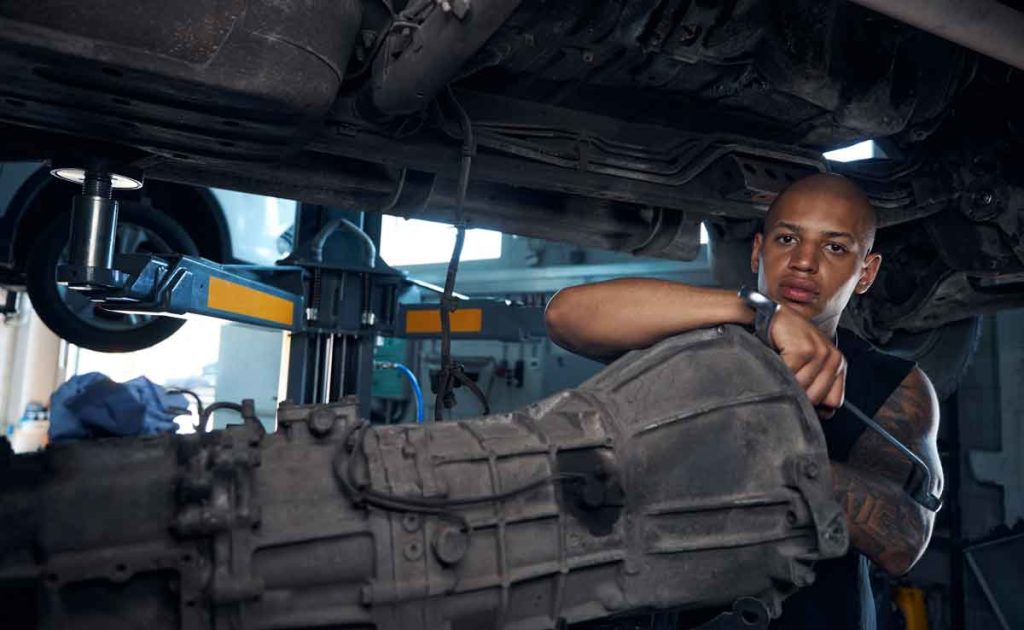
Installing Your Used Transmission: Tips and Necessary Parts
After successfully acquiring a used transmission from a junkyard, the next critical step is the installation process. This section provides valuable tips and outlines the necessary parts and considerations for a successful transmission installation.
Pre-Installation Inspection
Before installation, conduct a thorough inspection of the used transmission. Ensure that there are no cracks, leaks, or visible damage. It’s also advisable to replace certain parts before installation for optimal performance.
Necessary Replacement Parts
- Transmission Filter: Replacing the transmission filter is essential for preventing any existing contaminants from damaging your newly acquired transmission.
- Gaskets and Seals: New gaskets and seals should be used to avoid leaks. This includes the main seal and the pan gasket.
- Transmission Fluid: Use the type of transmission fluid recommended for your specific transmission model.
Tools and Equipment for Installation
Ensure you have all the necessary tools for installation, which typically include wrenches, sockets, a torque wrench, and a transmission jack.
Installation Process
- Mounting the Transmission: Carefully align and mount the transmission onto your vehicle, ensuring it fits securely.
- Connecting Components: Reattach all necessary components, including the torque converter, linkage, and electrical connections.
- Fluid Levels: After installation, check and adjust the transmission fluid level according to the manufacturer’s specifications.
Seeking Professional Assistance
If you’re not confident in your ability to install the transmission, seeking professional help is advisable. A skilled mechanic can ensure the installation is done correctly, which is vital for the transmission’s functionality and longevity.
Post-Installation Checks
After installation, conduct a series of checks:
- Leak Test: Check for any leaks around the transmission.
- Test Drive: Perform a test drive to ensure the transmission is functioning properly. Pay attention to shifts and any unusual noises.
Ensuring Proper Installation
Proper installation is crucial for the performance and durability of the used transmission. Take your time, follow the guidelines, and don’t hesitate to seek professional advice if needed.
By following these tips and ensuring you have the necessary parts and knowledge, installing a used transmission can be a rewarding and cost-effective solution for your vehicle’s transmission needs.
Conclusion: Maximizing Value and Reliability in Used Transmission Purchases
In conclusion, buying a used transmission from a junkyard can be a wise decision, offering a balance of cost-effectiveness, reliability, and environmental responsibility. By following the tips and considerations outlined in this guide, you can ensure that you get the best possible deal while contributing to sustainable auto recycling practices.
Purchasing a used transmission from a junkyard is a decision that can yield considerable benefits, both financially and environmentally. This comprehensive guide has aimed to equip you with the knowledge and insights needed to make an informed choice when navigating the world of used auto parts.
Recap of Key Points
- Cost-Effectiveness: We explored the significant savings that can be achieved by opting for a used transmission over a new or rebuilt one, without compromising on quality and performance.
- Choosing the Right Junkyard: Identifying a reputable junkyard with a good inventory and customer-friendly policies, including warranties, is crucial for a satisfactory purchase.
- Inspection and Selection: We discussed the importance of thorough inspection and careful selection of the transmission, emphasizing the need to check for damage, fluid quality, and overall condition.
- Installation and Maintenance: Tips on installing the used transmission and the importance of using new seals, gaskets, and appropriate transmission fluid were highlighted to ensure the longevity of your purchase.
The Bigger Picture
Beyond the immediate benefits, opting for a used transmission supports sustainability and recycling in the automotive industry. By choosing used parts, you contribute to reducing waste and conserving resources, aligning your vehicle repairs with eco-friendly practices.
Final Thoughts
With the right approach, purchasing and installing a used transmission can be a rewarding experience. It’s an opportunity to save money, learn more about your vehicle, and make a choice that benefits both your wallet and the planet.
As you embark on your journey to find the perfect used transmission, remember that patience, research, and a little bit of expertise can go a long way in ensuring a successful and satisfying experience.
USED Transmissions FAQs
What are the main benefits of buying a used transmission from a junkyard?
The primary benefits are significant cost savings compared to new or rebuilt transmissions, environmental sustainability through recycling, a wide selection of parts for various vehicle models, and the availability of warranties for added security.
How can I ensure the quality of a used transmission?
Conduct a thorough inspection for external damage, check fluid quality, assess the vehicle’s collision history, and look for signs of wear or damage. Choosing transmissions from vehicles with rear or side collisions can also be a safer bet.
What should I look for in a junkyard when buying a used transmission?
Look for a junkyard with a good reputation, a wide selection of parts, clear warranty policies, knowledgeable staff, and a systematic organization of their inventory.
What should I look for in a junkyard when buying a used transmission?
Look for a junkyard with a good reputation, a wide selection of parts, clear warranty policies, knowledgeable staff, and a systematic organization of their inventory.
Are warranties important when buying a used transmission?
Yes, warranties are crucial as they provide assurance of the transmission’s reliability and cover you in case of any issues post-installation.
What tools do I need to remove a transmission from a junk car?
Essential tools include a set of wrenches and sockets, screwdrivers, a transmission jack, pry bar, torque wrench, gloves, safety glasses, penetrating oil, and a drain pan.
Can I install a used transmission myself?
While it’s possible to install a used transmission yourself, it requires mechanical knowledge and the right tools. If you’re not experienced, it’s advisable to seek professional help.
How do I maintain my used transmission after installation?
Regularly check the transmission fluid level and quality, adhere to your vehicle’s maintenance schedule, and promptly address any unusual noises or shifts in performance.
Where can I buy a used transmission for a used car?
You can buy used transmissions for sale from various auto parts stores, junkyards or salvage yards, private sellers, or even used transmissions online. Always ensure you buy from a reputable source to get a quality transmission and warranty.
What should be my considerations while buying used transmissions?
When buying used transmissions, there are several factors to consider. You’ll want to ensure the transmission is tested for quality, fits your vehicle’s transmission specifications, and comes at a price that saves you time and money compared to a remanufactured transmission. Also, consider a full-service option if you’re not comfortable with the installation process.
Is it more economical to buy used transmissions or invest in transmission repairs?
If your transmission breaks, you can save money by purchasing a used one instead of getting expansive transmission repairs. Buying from a local junkyard or finding quality used transmissions online could save you a significant amount of cash.
What’s the difference between buying used transmissions from an auto parts store and a junk yard?
Buying a used transmission from an auto parts store usually means the part has been tested for quality and is often a safer option. A junkyard, on the other hand, may offer cheaper prices but the parts are generally as-is and may require additional investments for ensuring safety and functionality.
Is buying used transmissions for sale a good idea?
Yes, finding quality used transmissions can be a good idea, especially if you’re looking to save cost. It’s an ideal choice if you can find what you need from trustworthy sources that stand behind the quality and performance of their used car parts.
How do I ensure the quality of the used transmissions I buy?
It’s essential to make sure that a trained automotive technician tests the used transmission. Also, find out if the used transmission parts come with a warranty. This coverage can help if there are any issues down the line.
Is there any risk in buying used transmissions online?
There can be risks associated with buying used transmissions online – such as not being able to assess the part’s quality in-person or the part not being a right fit for your vehicle. However, buying online provides access to nationwide listings, allowing you to find specific parts needs more easily than local shops can offer.
What should I do if the used transmission I buy makes noise?
Noise from the transmission could indicate a problem. You should take it to a professional technician for a diagnosis. If it turns out to be a problem with the transmission itself, contact the seller immediately for a refund or replacement if you’ve purchased a high-quality transmission with a warranty.
Can buying used transmissions help me get my vehicle back on the road quicker?
Yes, purchasing a used transmission can shorten the time it takes to get your vehicle back on the road. Many used parts are readily available and it eliminates the wait time associated with remanufacturing a transmission.
